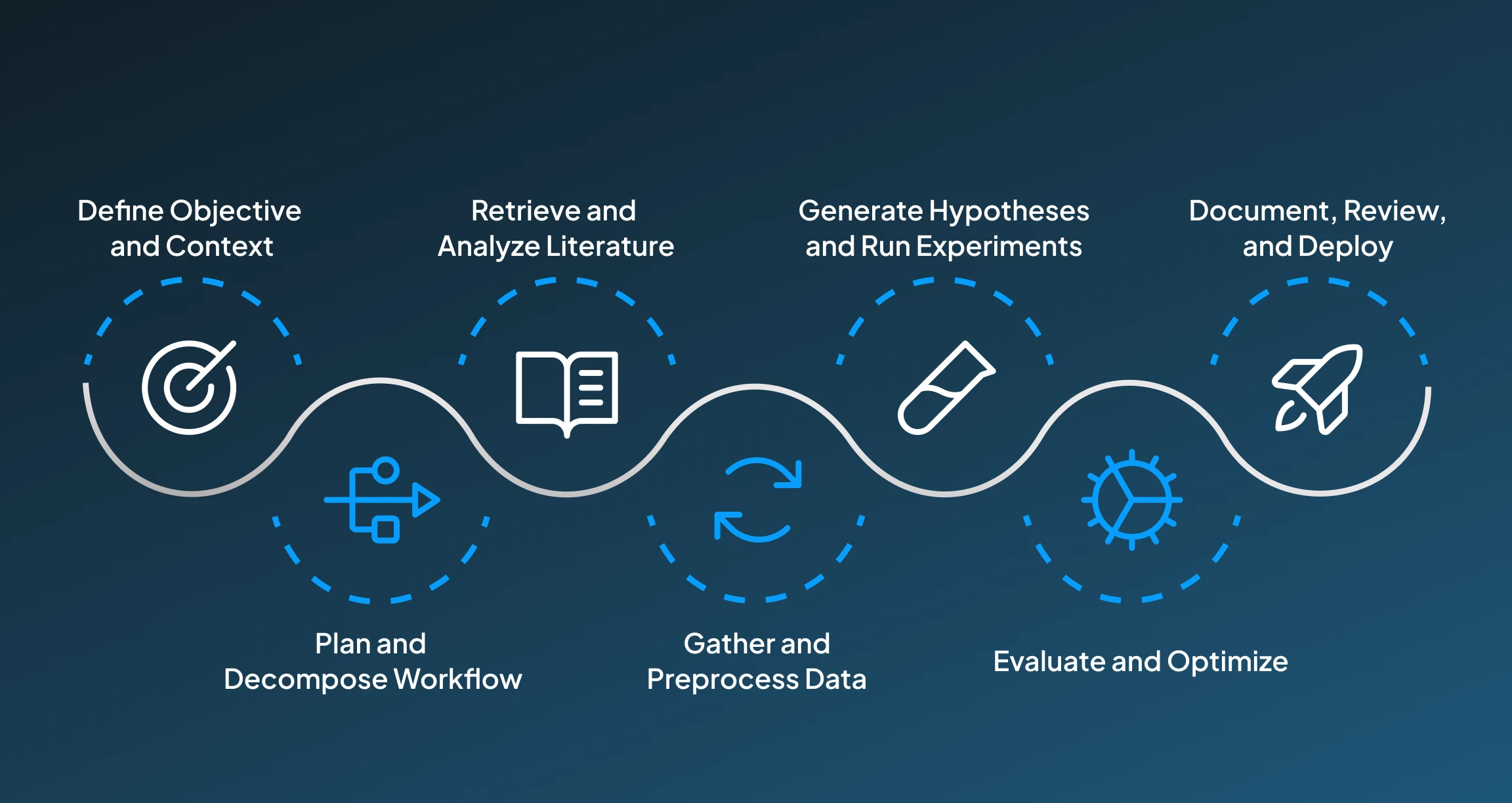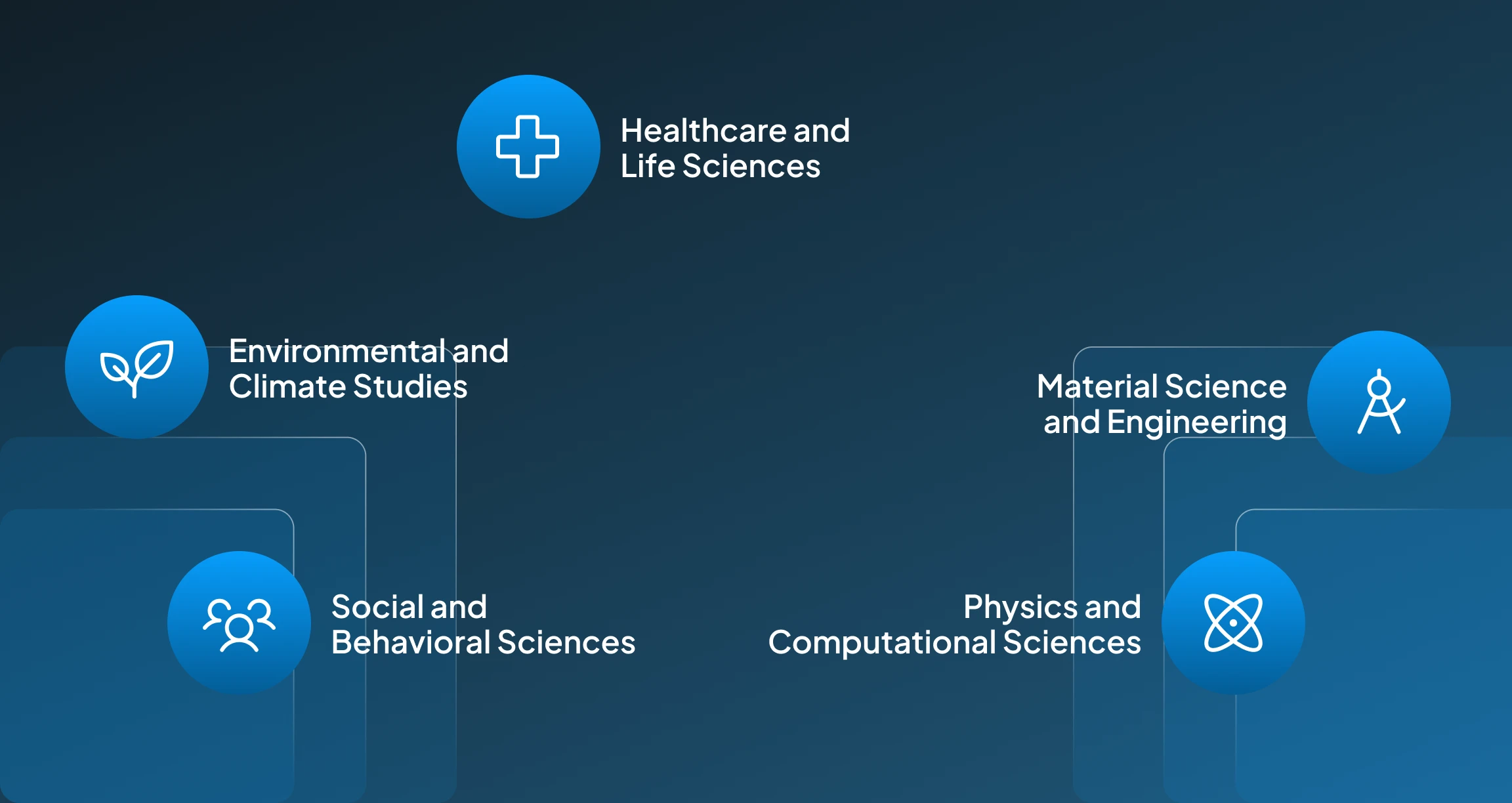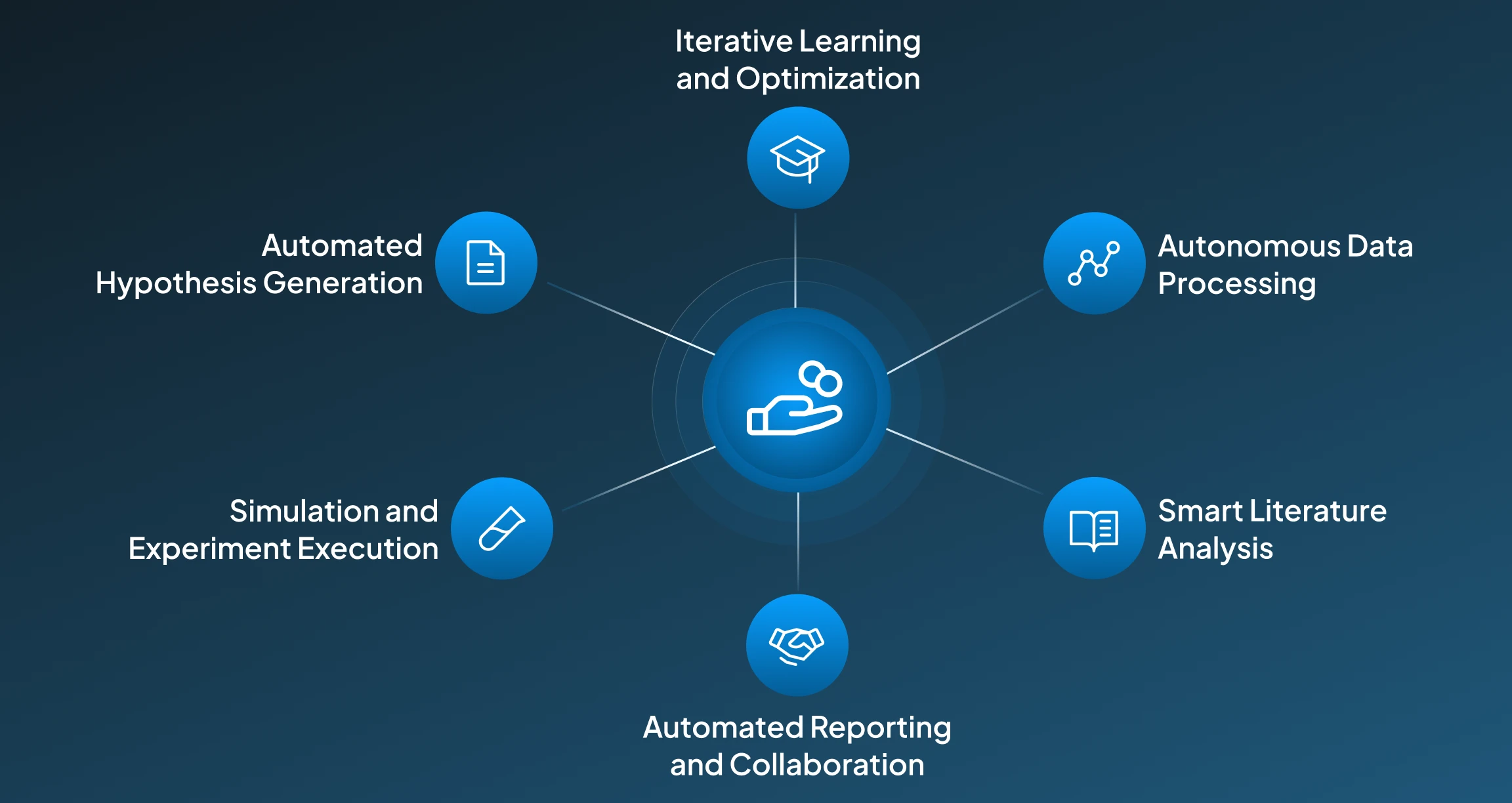AI Agents in Research: Key Applications, Capabilities, and Problem-Solving.
Discover how AI agents transform research through automation, smart analysis, and hypothesis generation to solve complex problems efficiently.
9/29/2025
artificial intelligence
10 mins

AI agents have recently been successful enough to make a wave for powering various business applications. Introducing such advancements and performance has attracted a significant market to integrate these solutions for strengthening their everyday workflow. While research used to be a tedious, time-intensive task back then, with AI agents in research, it has resulted in a focused and efficient research process.
Thus, with AI agents in research workflows, researchers are getting a reliable assistant that efficiently handles their daily research routines. These AI agent tools are not like any other automation tool; rather, they adapt to particular researchers' everyday work patterns, preferences, and thinking ability to help them in getting their research dependencies done.
With our article on AI agents in research, we will assist you in understanding how these work, their applications, advantages, and limitations for solving complex problems. This will eventually make you plan its adoption and implementation accordingly for your daily research work requirements.
AI Agents in Research
AI agents in research involve designing systems that can autonomously analyze data, generate hypotheses, and automate experimentation. These tools help in optimizing research-based discovery by analyzing the vast amount of data to simulate reasoning and collaborating with humans or other agents. Such solutions speed up innovation, enhance accuracy, and help in making groundbreaking research across domains like biology, physics, and social sciences.
What is the impact of AI agents in Research?
Quality research traditionally is a time and resource-intensive task, making experimentation with a hypothesis a prolonged journey. When it comes to research, a detailed and thorough study on every aspect plays an important role in leading to the most accurate conclusion. But in today's world, we need super-efficient solutions for every field, be it healthcare, finances, law, applied sciences, or arts, to keep up with the rapid evolution.
As a researcher handling too many tasks like reviewing literature, gathering data, performing simulations, and verification becomes very demanding. This further adds delay in the process, especially if it's being handled individually or within limited available resources.
Here, AI agents for performing research tasks appear as a reliable assistant that can share your research workload. These tools help in tasks like gathering data, studying competitors, providing detailed analysis, making simulations, or performing implementation, eventually making research more efficient and smarter. These rapid revolutions have convinced Demis Hassabis(CEO and Co-founder), as he once said:
“AI is the most powerful technology for accelerating scientific discovery that humanity has ever created.”
How do AI agents perform research?
AI agents in research workflows can act as an intelligent and proactive helping hand. With its working architecture, it can execute complex and long research responsibilities within in few minutes. While reducing the work time, it also ensures that the produced work for research remains consistent, accurate, and reliable. Below, we have provided a breakdown of the steps that function behind these AI agents for research workflows:

Step 1: Define Objective and Context
AI agents for research workflows start their functioning by defining some research goals. These research goals are defined in terms of embedding models to understand context. Additionally, under this step, they structure inputs into machine-readable objectives by conserving the background data in vector databases for semantic retrieval. By doing this, it ensures clarity and contextual consistency across the research process.
Step 2: Plan and Decompose Workflow
Then these AI Agents initiate to autonomously break the defined objectives into smaller subtasks using reasoning frameworks like ReAct. This step helps in designating duties to sub-agents for literature mining, data processing, modeling, and evaluation, while optimizing task order and dependencies for efficient research execution.
Step 3:Retrieve and Analyze Literature
With its embedding-based semantic search and summarization models, these AI agents work to extract insights from academic databases. Furthermore, they create knowledge graphs to link concepts, find out research gaps, and synthesize prior findings into structured summaries, which helps in guiding hypothesis generation and experimental direction.
Step 4: Gather and Preprocess Data
In this step, these AI Agents collect datasets via APIs or crawlers, further clean, filter, and normalize them by utilizing ETL pipelines. Under this step, it also looks for anomalies through unsupervised learning. At the end of this step, the data is formatted and stored in databases for efficient analysis, to ensure quality and readiness for model training or simulations.
Step 5: Generate Hypotheses and Run Experiments
By utilizing techniques like Bayesian reasoning and causal inference, these AI agents suggest hypotheses and choose experimental setups. By training models or running simulations, it executes hyperparameter optimization, helping these AI agents to achieve optimal configurations and reliable results for research tasks.
Step 6: Evaluate and Optimize
Then the AI Agents start analyzing the outputs statistically, to validate performance through cross-validation, and apply explainability tools like SHAP or LIME. With the integration of reinforcement learning or AutoML, it iteratively refines models and hypotheses to provide improved accuracy, reliability, and efficiency over multiple experimental cycles.
Step 7: Document, Review, and Deploy
Finally, the AI Agents produce structured reports using natural language generation tools, visualize findings, and automate documentation. The generated results then undergo human-in-the-loop validation before being pushed or deployed as APIs on platforms like Hugging Face or research artifacts on Zenodo for collaboration and reproducibility.
Applications of AI Agents for Different Research Works
AI agents for research tasks can have far-reaching benefits to strengthen and speed up the research dependencies. Its application across various fields can contribute to streamlining daily workflows, making analysis, simulation, and evaluation easier, while allowing you to focus on producing reliable research. Here are some key areas of applications where the integration of AI agents can do wonders:

1. Healthcare and Life Sciences:
AI agents for performing research tasks can help in accelerating drug discovery, genomics research, and clinical trial analysis by simulating molecular interactions. Such a tool can perform mining of biomedical literature and predict treatment outcomes through data-driven models, making research, testing, and production faster and more precise.
2. Environmental and Climate Studies:
Such an AI agent-based research tool can be utilized for analyzing satellite data, modeling climate patterns, and predicting natural disasters. Doing these tasks significantly helps researchers in designing sustainable solutions and assessing the environmental impact of human activities. Eventually contributing to extending impactful research for environmental and climate studies.
3. Material Science and Engineering:
AI Agents for research workflows can simulate material properties, automate experimental design, and identify optimal compounds for electronics, energy storage, or construction through computational modeling and predictive analytics. This helps in reducing the time spent on continuous loops of research and development, while ensuring credible research findings.
4. Social and Behavioral Sciences:
Such AI agents can efficiently contribute to analyzing large-scale survey data, studying social trends, and modeling human behavior, providing insights into policy-making, psychology, and economics using advanced statistical and NLP techniques. Thus, it helps in doing deep studies to validate the credibility of a certain hypothesis.
5. Physics and Computational Sciences:
AI agents can also assist in simulating complex systems, analyzing particle collisions, and optimizing algorithms for astrophysics, quantum computing, and high-performance simulations, reducing computation time and improving model precision. Through such implementation, it reduces the cost spent on experimentation, and still results in producing reliable research works.
Key Capabilities of AI Agents in Research
AI agents have ensured enhanced operations for the duties whereever they have been integrated. So, this AI Agent-driven solution for carrying out research responsibilities also holds immense potential to ensure convenience for research process demands. To help you in developing a better understanding, some key capabilities of AI agents in research have been mentioned below:

1. Autonomous Data Processing:
AI agents implemented for research workflow can work to automatically collect, clean, and structure large datasets from multiple sources. This helps such agents to ensure accuracy and consistency for downstream analysis. (Shaolei et al., 2025)
2. Smart Literature Analysis:
Such AI agents for research can perform semantic searches across research databases. It can also summarize key findings and extract key insights or research gaps using NLP and knowledge graph techniques, reducing the need for researchers to go through multiple research papers for skimming information.
3. Automated Hypothesis Generation:
These AI agent tools can perform prior analysis to propose new hypotheses and experimental setups. Their reasoning and probabilistic modeling ensure that the generated hypothesis remains logical and consistent with the respective discipline's knowledge. (Tong et al., 2024)
4. Simulation and Experiment Execution:
AI agents can also help design or run simulations and experiments. These agents work to optimize parameters and monitor results using advanced ML frameworks and distributed computing, ensuring that the simulation and execution remain aligned with the provided instructions.
5. Iterative Learning and Optimization:
By using reinforcement learning and feedback loops, AI agents can refine models, adapt methods, and continuously improve accuracy and efficiency. This enables them to make sure that the AI agent remains updated with evolving trends and ensures reliable research workflows throughout.
6. Automated Reporting and Collaboration:
They generate structured research summaries, visualizations, and publications, and collaborate with human researchers or other agents to ensure transparency and reproducibility.(Chris Lu et al., 2024)
Limitations of AI agents in Research
While AI agents greatly enhance research efficiency and automation, they also face notable challenges. These include limitations in understanding, reasoning, data quality, ethical transparency, computational demands, and dependence on human oversight for validation and decision-making.
1. Limited Domain Understanding:
AI agents rely heavily on the quality of training data and may misinterpret complex, domain-specific nuances that require expert judgment.
2. Data Quality and Availability Issues:
Incomplete, biased, or low-quality data can lead to inaccurate conclusions or misleading correlations in research outputs.
3. Lack of True Reasoning and Creativity:
While AI agents can simulate reasoning, they lack the genuine intuition, critical thinking, and creative insight that human researchers bring.
4. High Computational and Resource Costs:
Training and running advanced AI agents require significant computational power, memory, and infrastructure, making them expensive for many institutions.
5. Ethical and Reproducibility Concerns:
Without transparency in model decision-making or data provenance, AI-driven research can face issues of bias, lack of reproducibility, and questionable ethics.
6. Dependence on Human Oversight:
Despite automation, AI agents still require human supervision for validation, interpretation, and ethical compliance, limiting full autonomy in critical research areas.
Advancing the Future of AI-Driven Research
AI agents are transforming the research landscape by automating data analysis, literature review, and experimentation, enabling faster, data-driven discoveries. Their ability to process vast information and generate hypotheses offers researchers unprecedented efficiency and innovation potential.
However, successful adoption requires addressing challenges like data quality, interpretability, ethical transparency, and computational costs. Researchers should integrate AI agents as collaborative partners, augmenting rather than replacing human insight.
Building interdisciplinary teams, ensuring model accountability, and maintaining human oversight will be key to maximizing their impact. Embracing AI agents strategically can accelerate scientific progress while preserving the rigor, ethics, and creativity that define quality research.
Ready to explore how AI agents can accelerate your research and innovation? Book a session today with our expert engineers at Centrox AI to see them in action and transform your research workflow.

Muhammad Harris
Muhammad Harris, CTO of Centrox AI, is a visionary leader in AI and ML with 25+ impactful solutions across health, finance, computer vision, and more. Committed to ethical and safe AI, he drives innovation by optimizing technologies for quality.
Do you have an AI idea? Let's Discover the Possibilities Together. From Idea to Innovation; Bring Your AI solution to Life with Us!
Your AI Dream, Our Mission
Partner with Us to Bridge the Gap Between Innovation and Reality.
